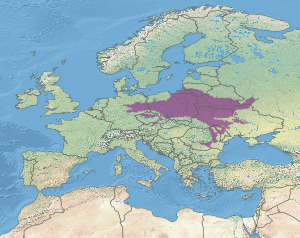Central European mixed forests
| Ecoregion: Central European mixed forests | |
|---|---|
 Białowieski National Park, in the ecoregion | |
 Ecoregion territory (in purple) | |
| Ecology | |
| Realm | Palearctic |
| Biome | Temperate broadleaf and mixed forest |
| Geography | |
| Area | 727,269 km2 (280,800 sq mi) |
| Countries | Austria, Belarus, Czech Republic, Germany, Lithuania, Moldovia, Poland, Romania, Russia, Ukraine |
The Central European mixed forest ecoregion (WWF ID:PA0412) is a temperate hardwood forest covering much of northeastern Europe, from Germany to Russia. The area is only about one-third forested, with pressure from human agriculture leaving the rest in a patchwork of traditional pasture, meadows, wetlands. The ecoregion is in the Temperate broadleaf and mixed forest biome, and the Palearctic ecozone, with a Humid Continental climate. It covers 731,154 km2 (282,300 sq mi).[1]
Location and description
The ecoregion covers the formerly-glaciated central plains of Central Europe, from eastern Germany and the shores of the Baltic Sea, through large parts of the Czech Republic, Poland, Lithuania, and Belarus, Ukraine and a small part of Russia (in Bryansk Oblast). The terrain is mostly flat lowlands in the center, hilly moraine-dominated in the north, and uplands to the south along the Carpathian mountains.[1][2] To the north is the Sarmatic mixed forests ecoregion, the forests of which feature more spruce and pine. To the east is the East European forest steppe, in which the forest stands thin out into grasslands. To the south is the Carpathian montane forests ecoregion, featuring mountain pastures and forests of beech, spruce, elm, and dwarf pine.[1] To the north are the Mixed Baltic forests of oaks, hornbeam, and linden trees on flat, acidic soils. To the west is the Western European broadleaf forests ecoregion, which is now mostly cultivated agricultural land.
Climate
The region has a Humid continental, cool summer climate (Koppen classification (Dfb)). This climate is characterized by high variation in temperature, both daily and seasonally; with relatively cool summers. The "cool summer" designation indicates that at least no month averages above 22 °C (72 °F). The summers become hotter and the winters colder as you move east across the ecoregion, due to the movement towards the center of the continent ("continentality"). The mean January temperature is −1 °C (30 °F) in Germany to −6 °C (21 °F) in Belarus. Precipitation average between 500 mm and 700 mm, mostly falling during the summer growing season.[2]
Flora and fauna
Oak forests are characteristic throughout the region, with some pine forests in the north. Forest cover ranges from 15% in Ukraine to 33% in the Czech Republic.[2] The most common tree in the ecoregion, covering half of the forested area, is the Scots pine (Pinus sylvestris), which has been planted extensively over the past 200 years.[2] The truly mixed deciduous forests have been replaced mostly by agriculture. The non-forested areas are largely meadows and pastures dedicated to human agricultural uses. There are also extensive wetlands in the lowlands. The wetlands support diverse bird communities, but mammals are heavily pressured by human land use. Because of the uniformity of the terrain and openness to other regions, there are no endemic species in the ecoregion. In some countries, 20-30 of the mammal species are threatened.[2]
Protections
The Central European mixed forest has been affected heavily by human pressure. Most protected areas of nature are small and fragmented. Some of the large or more representative protected areas in the ecoregion include:
- Belovezhskaya Pushcha National Park / Białowieża National Park, are the Belarus and Polish sides, respectively of the side of the Białowieża (Area: 1,500 km2 / 150 km2)
- Białowieża Forest (Belarus, Poland), the last large fragment of Old-growth forest that used to stretch across the European Plain. P(Area: 3,086 km2)
- Biebrza National Park, the largest national park in Poland, is 25% forested, the remainder is field, meadow, and marsh. (Area: 592 km2)
- Bryansky Les Nature Reserve, is an area of old-growth forest on the eastern tip of the ecoregion in Bryansk Oblast, Russia. (Area: 122 km2)
- Lower Polissia National Nature Park, in northwestern Ukraine, is representative of teh Polesia area of Poland, Belarus, Ukraine and Russia. (Area: 88 km2)
- Middle Elbe Biosphere Reserve, stretches along the Elbe River in Saxon-Anhalt, Germany, covering the largest river-meadow complex in Middle Europe. (Area: 430 km2)
- Narew National Park (Poland), covers wetlands along the moraines of the Narew river, exemplifying a Braided river. (Area: 78 km2)
See also
References
- 1 2 3 "Central European mixed forest". Ecoregions of the World. GlobalSpecies.org. Retrieved August 14, 2018.
- 1 2 3 4 5 "PA0412: Central Europe: Austria, Belarus, Czech Republic, Germany, Lithuania, Moldovia, Poland, Romania, Russia, and Ukraine". World Wildlife Federation. Retrieved August 14, 2018.